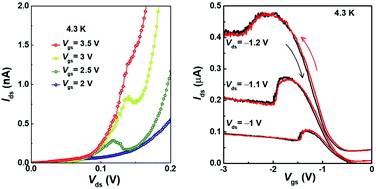Negative transconductance and negative differential resistance in asymmetric narrow bandgap 2D–3D heterostructures†
Abstract
Two-dimensional layered black phosphorus is an ambipolar narrow bandgap semiconductor with excellent electronic properties. A heterostructure can be formed when black phosphorus is combined with a narrow bandgap n-type semiconductor, which can feasibly be modulated throughout the entire bandgap for both materials in momentum space, creating unique quantum tunneling devices. In this work, a black phosphorus and narrow bandgap n-type indium arsenide heterojunction is created with a broken-gap band alignment, forming two interband tunneling windows that can be modulated electrostatically. We observe simultaneous gate-tunable band-to-band tunneling induced negative differential resistance and negative transconductance in the heterointerface and the access region edge near the gate, respectively. Compared to the stringent conditions for realizing such abrupt heterojunctions with opposite doping polarities in conventional bulk semiconductors, layered two-dimensional materials provide unique opportunities for such quantum tunneling devices. Our results represent advances in the fundamental understanding of heterojunctions and will promote future applications in advanced electronics.



 Please wait while we load your content...
Please wait while we load your content...